
Meade's LX200
Introduction
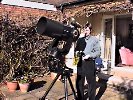 |
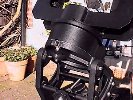 |
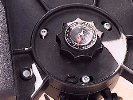 |
| fig 1 (33K jpg) |
fig 2 (28K jpg) |
fig 3 (22k jpg) |
Click on any pictures on this page for an enlarged
view - return by right clicking the mouse
Any of the modern astronomy magazines will have adverts for, images taken
with or articles written by people using the famous Meade LX200 series of
telescopes, it is probably the most advanced amateur telescope available
'off the shelf' and has features only dreamt of a few years ago.
The LX200 SCT series range in size from 8 inches to 16 inches, and are available
in either f10 or f6.3 focal ranges, the one reviewed here is their 10 inch
f10 model.
The main advantage of the LX200 series is the built in computer control,
which claims to be accurate enough to place virtually any object onto the
CCD chip of any commercially available CCD camera, together with a built
in library exceeding 12,000 objects available to 'click and go'. Certainly
the slewing speed is impressive, using dc servo motors fed with a series
of pulses, however the very accurate polar alignment needed (when using the
equatorial wedge) to achieve the claimed accuracy isn't available using the
compass, bubble level and latitude scale of the Meade mount (see fig. 3).
Given that most LX200's seem to be used with an equatorial wedge, it's surprising
that more attention wasn't paid to level and latitude setting. In any event
it can usually be ignored as two star alignment is available most of the
time, except for solar work and daytime observation of planets etc.
It's nice to have a system that can be pointed to a couple of stars, adjusted,
a CCD camera fitted and focused, then choose any one of thousands of objects
and just acquire them without further user intervention, your very own automatic
'robotic' telescope. This is possible even with the alt-azimuth mode, using
the Meade series of CCD cameras and their motorised focus assembly! However
the maximum exposure is limited by field rotation when used like this and
most users seem to prefer the wedge option.
One point worthy of note is the high precision pointing (HPP) that Meade
are so fond of quoting, a careful read of the user manual gives their game
away as to how this works and it's nothing special! If you wish to find a
faint object using HPP, you are taken to align on three stars near the object,
these are typically magnitude 3 or brighter, finally the scope moves onto
the faint object. Using fairly crude digital circles I can achieve the same
result in less time and with less of a song and dance about it.
Most mounts seem to have a real mess of trying to implement periodic error
correction (PEC). This is where you can record your tracking corrections
and replay them over and over again. Periodic errors are mainly due to
imperfections in the worm wheel on the ra drive of the mount. Meade
have introduced permanently programmed PEC, a great idea as other mounts
(the Losmandy G-11, for instance) loose the PEC settings when you slew the
mount! When I have some measurements of the actual errors in this mount,
I'll post details here.
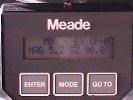 |
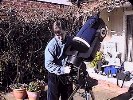 |
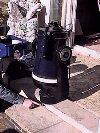 |
| fig 4 (14K jpg) |
fig 5 (35K jpg) |
fig 6 (26k jpg) |
Many of the advantages and disadvantages of the LX200 are common to any fork
mounted SCT, these are:
Advantages
1. in the 8 inch sizes fairly portable and easy to set up, less so for 10
inch and 12 inch models.
2. probably better value for money than a similar computer controlled
telescope.
3. closed optical system and excellent optics for minimal tube currents and
reduced tarnishing of mirrors.
4. solid coupling for photographic accessories and off-axis guider. The wide
range of focus adjustment allows accessories to be easily fitted, examples
include Barlow lenses, flip mirrors and off-axis guiders (the flip mirrors
are especially good with a CCD camera). It is generally easier to keep
'north up' with a CCD camera when using a fork mount compared to a German
equatorial.
5. ability to mount without the 'Super Wedge' and have auto locate for thousands
of objects at any location in the world (fig 4).
6. wide range of accessories, many of the Celestron accessories also fit
Meade.
7. compatible with Meade CCD cameras for auto focus, auto tracking and auto
mosaic images.
Disadvantages
1. even though it represents good value for what it offers, the cost including
equatorial wedge, dew shield, corrector plate heater etc. is far higher than
a basic Newtonian telescope of equal or better optical performance.
2. for the 10 inch and 12 inch models the optical tube assembly is very heavy
(10 inch OTA & fork, around 60 pounds), it can be quite difficult to
locate the fixing bolts in the dark (see fig. 2), a few people have dropped
the tube assembly either due to fatigue or missing the bolt fixing, these
tube assemblies are generally written off by such an accident! Care is needed
when placing the tube and fork assembly down after removing it from the
tripod/wedge, it is safer to leave the top bolt in place but this means finding
a suitable perch for the telescope in order to remove the bolt for transport,
see fig 6.
3. the focus mechanism moves the main mirror, it doesn't have a turns counter
and actually moves the image slightly sideways as the focus is adjusted,
this could cause problems with a CCD camera, other SCT users tell me this
is a common occurrence and there is little that can be done. The Celestron
'Ultima' series has a multi-turn counter that makes CCD focus adjustment
relatively easy, I can still remember setting '1410' when using one with
my Starlight Express camera.
4. there was mechanical play in both ra and dec (should be possible
to tighten this).
5. due to the design of the fork mount, there is a problem with mounting
cameras and trying to swing the instrument either overhead (when not fitted
with the wedge) or through the polar regions with the wedge.
6. it is possible to damage the gears by hand moving the telescope without
slackening the clutches, the same may be true for jamming the instrument
against the fork mount with a camera and trying to continue slewing. Neither
of these problems occur with a German equatorial mount.
7. In common with many fork mounted telescopes, there is no polar alignment
telescope. Accurate polar alignment is only possible by the drift method,
this can take an hour or more. By comparison, Vixen and Losmandy german
equatorial mounts can be fitted with very accurate polar alignment scopes
in their polar axis.
Having mentioned that I was including a Meade LX200 review in this months
pages, my friend Steve Banbury sent this by e-mail:
One comment I have heard from 2 owners is that units are not equally
well aligned. My friend who dropped his reassembled it himself after Meade
basically told him it was scrap. He says he regularly achieves auto pointing
to any selected star close enough to be within the field of view of a 9 mm
eyepiece. His father's can not achieve this--and his wasn't dropped! Another
comment on the LX200. Subsequent to my friend dropping his, I have seen a
number of threads on sci.astro.amateur from other people seeking an after
market spring device that facilitates single individual mounting of the scope
in an alt-az configuration. Apparently numerous other people have experienced
"close calls"
Would I swop the main observatory instrument (a fork mounted 12 inch f5
Newtonian) for a 12 inch Meade LX200? Probably if I won the lottery! At more
than double the cost probably not. Is it better than a non computerised
instrument fitted with digital circles? Given the rather crude resolution
and mounting arrangement of most of the add-on digital circles, yes it probably
is.
Special thanks to David Clegg for demonstrating his Meade 10 inch f10 LX200.
Jump to top of page



|
